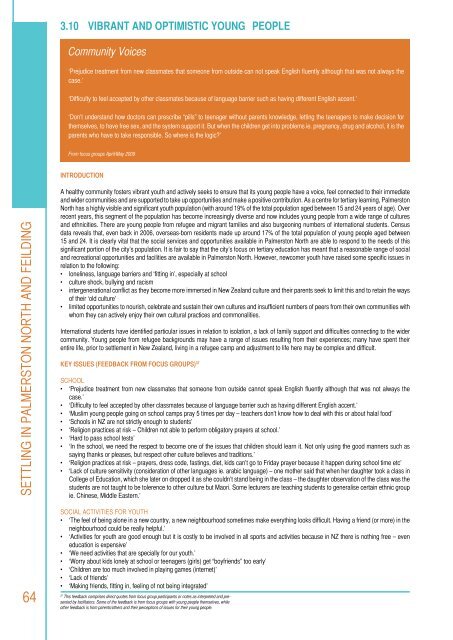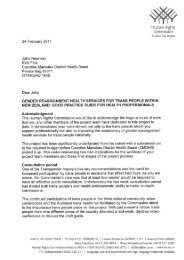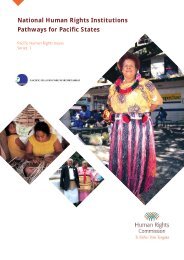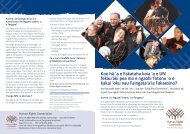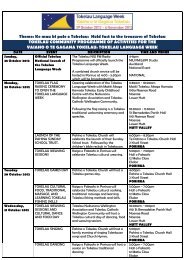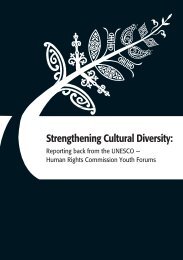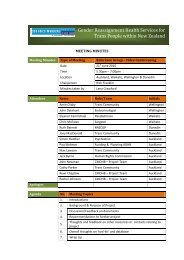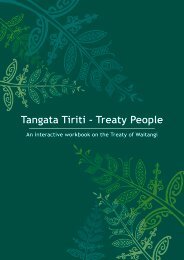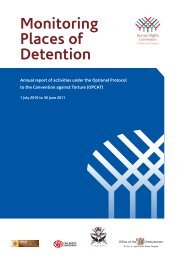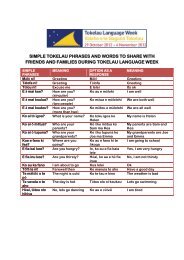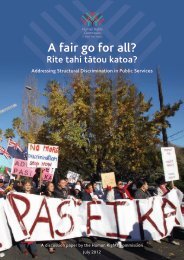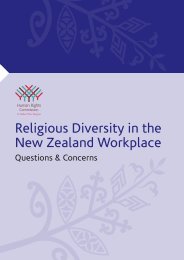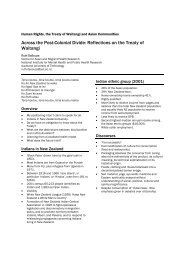Settling In Palmerston North and Feilding - Human Rights Commission
Settling In Palmerston North and Feilding - Human Rights Commission
Settling In Palmerston North and Feilding - Human Rights Commission
You also want an ePaper? Increase the reach of your titles
YUMPU automatically turns print PDFs into web optimized ePapers that Google loves.
3.10 VIBRANT AND OPTIMISTIC YOUNG PEOPLECommunity Voices‘Prejudice treatment from new classmates that someone from outside can not speak English fluently although that was not always thecase.’‘Difficulty to feel accepted by other classmates because of language barrier such as having different English accent.’‘Don’t underst<strong>and</strong> how doctors can prescribe “pills” to teenager without parents knowledge, letting the teenagers to make decision forthemselves, to have free sex, <strong>and</strong> the system support it. But when the children get into problems ie. pregnancy, drug <strong>and</strong> alcohol, it is theparents who have to take responsible. So where is the logic?’From focus groups April/May 2009<strong>In</strong>troductionSETTLING IN PALMERSTON NORTH AND FEILDINGA healthy community fosters vibrant youth <strong>and</strong> actively seeks to ensure that its young people have a voice, feel connected to their immediate<strong>and</strong> wider communities <strong>and</strong> are supported to take up opportunities <strong>and</strong> make a positive contribution. As a centre for tertiary learning, <strong>Palmerston</strong><strong>North</strong> has a highly visible <strong>and</strong> significant youth population (with around 19% of the total population aged between 15 <strong>and</strong> 24 years of age). Overrecent years, this segment of the population has become increasingly diverse <strong>and</strong> now includes young people from a wide range of cultures<strong>and</strong> ethnicities. There are young people from refugee <strong>and</strong> migrant families <strong>and</strong> also burgeoning numbers of international students. Censusdata reveals that, even back in 2006, overseas-born residents made up around 17% of the total population of young people aged between15 <strong>and</strong> 24. It is clearly vital that the social services <strong>and</strong> opportunities available in <strong>Palmerston</strong> <strong>North</strong> are able to respond to the needs of thissignificant portion of the city’s population. It is fair to say that the city’s focus on tertiary education has meant that a reasonable range of social<strong>and</strong> recreational opportunities <strong>and</strong> facilities are available in <strong>Palmerston</strong> <strong>North</strong>. However, newcomer youth have raised some specific issues inrelation to the following:• loneliness, language barriers <strong>and</strong> ‘fitting in’, especially at school• culture shock, bullying <strong>and</strong> racism• intergenerational conflict as they become more immersed in New Zeal<strong>and</strong> culture <strong>and</strong> their parents seek to limit this <strong>and</strong> to retain the waysof their ‘old culture’• limited opportunities to nourish, celebrate <strong>and</strong> sustain their own cultures <strong>and</strong> insufficient numbers of peers from their own communities withwhom they can actively enjoy their own cultural practices <strong>and</strong> commonalities.<strong>In</strong>ternational students have identified particular issues in relation to isolation, a lack of family support <strong>and</strong> difficulties connecting to the widercommunity. Young people from refugee backgrounds may have a range of issues resulting from their experiences; many have spent theirentire life, prior to settlement in New Zeal<strong>and</strong>, living in a refugee camp <strong>and</strong> adjustment to life here may be complex <strong>and</strong> difficult.Key Issues (feedback from focus groups) 37School• ‘Prejudice treatment from new classmates that someone from outside cannot speak English fluently although that was not always thecase.’• ‘Difficulty to feel accepted by other classmates because of language barrier such as having different English accent.’• ‘Muslim young people going on school camps pray 5 times per day – teachers don’t know how to deal with this or about halal food’• ‘Schools in NZ are not strictly enough to students’• ‘Religion practices at risk – Children not able to perform obligatory prayers at school.’• ‘Hard to pass school tests’• ‘<strong>In</strong> the school, we need the respect to become one of the issues that children should learn it. Not only using the good manners such assaying thanks or pleases, but respect other culture believes <strong>and</strong> traditions.’• ‘Religion practices at risk – prayers, dress code, fastings, diet, kids can’t go to Friday prayer because it happen during school time etc’• ‘Lack of culture sensitivity (consideration of other languages ie. arabic language) – one mother said that when her daughter took a class inCollege of Education, which she later on dropped it as she couldn’t st<strong>and</strong> being in the class – the daughter observation of the class was thestudents are not taught to be tolerence to other culture but Maori. Some lecturers are teaching students to generalise certain ethnic groupie. Chinese, Middle Eastern.’64Social Activities for Youth• ‘The feel of being alone in a new country, a new neighbourhood sometimes make everything looks difficult. Having a friend (or more) in theneighbourhood could be really helpful.’• ‘Activities for youth are good enough but it is costly to be involved in all sports <strong>and</strong> activities because in NZ there is nothing free – eveneducation is expensive’• ‘We need activities that are specially for our youth.’• ‘Worry about kids lonely at school or teenagers (girls) get “boyfriends” too early’• ‘Children are too much involved in playing games (internet)’• ‘Lack of friends’• ‘Making friends, fitting in, feeling of not being integrated’37This feedback comprises direct quotes from focus group participants or notes as interpreted <strong>and</strong> presentedby facilitators. Some of the feedback is from focus groups with young people themselves, whileother feedback is from parents/others <strong>and</strong> their perceptions of issues for their young people.


